Back in the late 1960s and early 1970s, LSD was a symbol of rebellion and freedom. It represented the counterculture movement that challenged the system. People used it to expand their minds, connect with others, and explore different levels of consciousness. The Woodstock generation saw it as a doorway to peace and creativity.
Fast forward to today, and LSD looks very different. In places like Silicon Valley, it has become a tool for focus and innovation. Instead of tripping for hours, people are now “microdosing,” taking very small amounts to boost creativity, improve mood, and sharpen their thinking.
Some studies suggest that small doses can improve mental function and may even be safe for healthy adults. Other researchers say that most of the effects people report could come from expectation and mindset, not the drug itself. Either way, the cultural meaning has changed. What once represented spiritual exploration now fits neatly into the work culture of tech startups and self-optimization.
Shrooms: From Sacred Ceremony to Wellness Trend
Psilocybin mushrooms have been used for centuries in indigenous and spiritual ceremonies. In those spaces, people were guided by shamans or elders who created a safe and meaningful setting. The goal was healing and connection, not recreation.
Today, those same mushrooms are part of a booming “retreat” industry. People travel across the world for weekend mushroom experiences that promise emotional breakthroughs and personal growth. While some do find peace or healing, others end up overwhelmed or unprepared. Hospitals have seen more emergency visits from panic attacks, paranoia, or bad reactions linked to unregulated use.
Researchers are studying psilocybin again and finding potential benefits for depression, trauma, and addiction. But experts also warn that these experiences should be guided and monitored to prevent harm. The line between sacred healing and luxury wellness has become blurry.
The Rise of New Synthetics
 Beyond LSD and shrooms, a new generation of designer psychedelics has arrived. Names like NBOMe, 2C-B, and DMT vapes are spreading quickly. They’re often sold online without regulation or proper labels. These substances are powerful, unpredictable, and sometimes dangerous.
Beyond LSD and shrooms, a new generation of designer psychedelics has arrived. Names like NBOMe, 2C-B, and DMT vapes are spreading quickly. They’re often sold online without regulation or proper labels. These substances are powerful, unpredictable, and sometimes dangerous.
Because they are made in underground labs, no one really knows what is in them or how strong they are. The result can be frightening. Some users feel extreme anxiety. They may have vivid hallucinations that seem real. Others face ongoing psychological stress. The pursuit of “new highs” can come with serious risks when safety and knowledge take a back seat.
Medical Research vs Underground Reality
Scientists are once again exploring psychedelics as medicine. Duke University and other schools are looking into how these substances might help treat depression, PTSD, and addiction. Early findings look good. Under trained supervision and in controlled settings, psychedelics might help people confront trauma or change unhealthy thoughts.
Meanwhile, outside the lab, underground use continues to grow. People are exploring their own ways, whether it’s backyard ceremonies or unlicensed therapy sessions. Some find real relief, while others end up lost or harmed. The gap between science and underground culture is growing. The talk about safety, freedom, and regulation is also expanding.
The story of psychedelics reflects the story of our society. What began as a rebellion and a search for meaning has shifted to productivity hacks, corporate retreats, and new market opportunities. The substances are the same, but the meaning has shifted.
As people rediscover these tools, the challenge is to learn to use them wisely. Awareness matters. Respect matters. Whether it is LSD at a festival or a psilocybin capsule in a clinic, the question remains the same: What are we really looking for when we alter our minds?


Leave a Reply